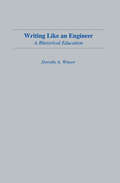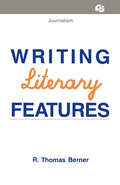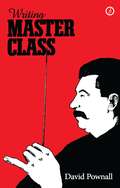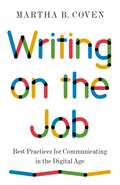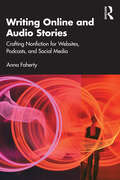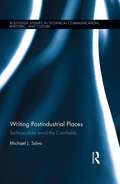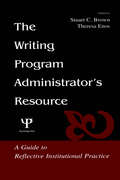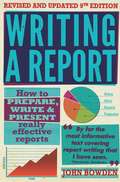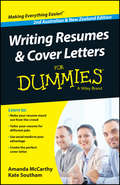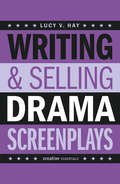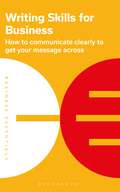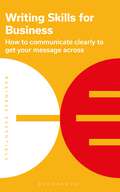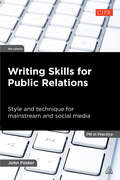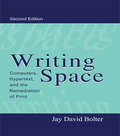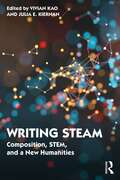- Table View
- List View
Writing Like An Engineer: A Rhetorical Education (Rhetoric, Knowledge, and Society Series)
by Dorothy A. WinsorComprised of a study spanning over five years, this text looks at four engineering co-op students as they write at work. Since the contributors have a foot in both worlds -- work and school -- the book should appeal to people who are interested in how students learn to write as well as people who are interested in what writing at work is like. Primarily concerned with whether engineers see their writing as rhetorical or persuasive, the study attempts to describe the students' changing understanding of what it is they do when they write. Two features of engineering practice that have particular impact on the extent to which engineers recognize persuasion are identified: * a reverence for data, and * the hierarchical structure of the organizations in which engineering is most commonly done. Both of these features discourage an open recognition of persuasion. Finally, the study shows that the four co-op students learned most of what they knew about writing at work by engaging in situated practice in the workplace, rather than by attending formal classes.
Writing Like An Engineer: A Rhetorical Education (Rhetoric, Knowledge, and Society Series)
by Dorothy A. WinsorComprised of a study spanning over five years, this text looks at four engineering co-op students as they write at work. Since the contributors have a foot in both worlds -- work and school -- the book should appeal to people who are interested in how students learn to write as well as people who are interested in what writing at work is like. Primarily concerned with whether engineers see their writing as rhetorical or persuasive, the study attempts to describe the students' changing understanding of what it is they do when they write. Two features of engineering practice that have particular impact on the extent to which engineers recognize persuasion are identified: * a reverence for data, and * the hierarchical structure of the organizations in which engineering is most commonly done. Both of these features discourage an open recognition of persuasion. Finally, the study shows that the four co-op students learned most of what they knew about writing at work by engaging in situated practice in the workplace, rather than by attending formal classes.
Writing Literary Features
by R. Thomas BernerFirst Published in 1988. Routledge is an imprint of Taylor & Francis, an informa company.
Writing Literary Features
by R. Thomas BernerFirst Published in 1988. Routledge is an imprint of Taylor & Francis, an informa company.
Writing 'Master Class'
by David PownallWriting Master Class is the biography of David Pownall’s play, Master Class (1983), from conception to coming of age. Threaded through the account of the inception and development of the piece are twists of authorial life-story necessary for the telling. Whereas a novel or poem can be kept a secret until it is properly finished, a play has to go out to meet the people early. On the day the script is put into the hands of actors, the soul of the thing passes out of the author’s control. It can be bent, battered, warped – or improved within its being far beyond expectations. As a drama of dictatorship in art and the cleverness needed to evade its worst manifestations, Master Class has been at large for thirty years, produced in twenty countries, in some several times. What has been done to it, how it has fared, is touched upon but the main story in this book is the making of the piece. This is a fascinating insight into the playwright’s craft.
Writing on the Job: Best Practices for Communicating in the Digital Age
by Martha B. CovenA practical and compact guide to writing for professionalsWriting is an essential skill in today’s workplace. From messaging platforms and social media to traditional forms of communication like memos and reports, we rely on words more than ever. Given how much reading we do on mobile devices, being able to write succinctly is critical to success. Writing on the Job is an incisive guide to clear and effective writing for professionals.Martha Coven begins with the basics, explaining how to develop a professional style, get started on a piece of writing, create a first draft, and edit it into a strong final product. She then offers practical advice on more than a dozen forms of writing, from emails and slide decks to proposals and cover letters. Along the way, Coven provides a wealth of concrete examples and simple templates that make the concepts easy to understand and apply.Based on Coven’s popular writing classes and workshops at Princeton University as well as her decades of experience in the public and private sectors, Writing on the Job addresses the real challenges professionals face in today’s digital age, and shares essential practices that can improve the performance of any organization.
Writing on the Job: Best Practices for Communicating in the Digital Age
by Martha B. CovenA practical and compact guide to writing for professionalsWriting is an essential skill in today’s workplace. From messaging platforms and social media to traditional forms of communication like memos and reports, we rely on words more than ever. Given how much reading we do on mobile devices, being able to write succinctly is critical to success. Writing on the Job is an incisive guide to clear and effective writing for professionals.Martha Coven begins with the basics, explaining how to develop a professional style, get started on a piece of writing, create a first draft, and edit it into a strong final product. She then offers practical advice on more than a dozen forms of writing, from emails and slide decks to proposals and cover letters. Along the way, Coven provides a wealth of concrete examples and simple templates that make the concepts easy to understand and apply.Based on Coven’s popular writing classes and workshops at Princeton University as well as her decades of experience in the public and private sectors, Writing on the Job addresses the real challenges professionals face in today’s digital age, and shares essential practices that can improve the performance of any organization.
Writing Online and Audio Stories: Crafting Nonfiction for Websites, Podcasts, and Social Media
by Anna FahertyGuiding readers through the unique challenges and choices presented by digital publication, this book provides a practical set of tools to help students, creatives, and content professionals craft emotionally engaging nonfiction stories for online readers and listeners. From considering what story to tell, to bringing narratives to life in practice, Anna Faherty explains what gives stories their unique power and demonstrates how to successfully combine techniques from short-stories and screenwriting with journalistic practices like fact checking and verification. Examples from corporate websites, personal blogs, podcasts, and social media set out how to attract and involve readers and listeners, and how to prompt them to take action. Readers will come away with a straightforward framework for planning and crafting storytelling projects and an understanding of text and script development, copyright, and editing. Each chapter includes summaries of key principles and practical writing tips, while case studies share insights from writers’ professional practices – including those who use storytelling to influence customers or advocate for change. Writing Online and Audio Stories is a valuable entry-point for creative writers, podcasters, and professionals in PR and marketing, as well as students undertaking courses such as Digital Writing, Creative Nonfiction and Multimedia Storytelling.
Writing Online and Audio Stories: Crafting Nonfiction for Websites, Podcasts, and Social Media
by Anna FahertyGuiding readers through the unique challenges and choices presented by digital publication, this book provides a practical set of tools to help students, creatives, and content professionals craft emotionally engaging nonfiction stories for online readers and listeners. From considering what story to tell, to bringing narratives to life in practice, Anna Faherty explains what gives stories their unique power and demonstrates how to successfully combine techniques from short-stories and screenwriting with journalistic practices like fact checking and verification. Examples from corporate websites, personal blogs, podcasts, and social media set out how to attract and involve readers and listeners, and how to prompt them to take action. Readers will come away with a straightforward framework for planning and crafting storytelling projects and an understanding of text and script development, copyright, and editing. Each chapter includes summaries of key principles and practical writing tips, while case studies share insights from writers’ professional practices – including those who use storytelling to influence customers or advocate for change. Writing Online and Audio Stories is a valuable entry-point for creative writers, podcasters, and professionals in PR and marketing, as well as students undertaking courses such as Digital Writing, Creative Nonfiction and Multimedia Storytelling.
Writing Postindustrial Places: Technoculture amid the Cornfields (Routledge Studies in Technical Communication, Rhetoric, and Culture)
by Michael J. SalvoExploring the relationship between postindustrial writing and developments in energy production, manufacturing, and agriculture, Michael J. Salvo shows how technological and industrial innovation relies on communicative and organizational suppleness. Through representative case studies, Salvo demonstrates the ways in which technical communicators formulate opportunities that link resources with need. His book is a supple articulation of the opportunities and pitfalls that come with great change.
Writing Postindustrial Places: Technoculture amid the Cornfields (Routledge Studies in Technical Communication, Rhetoric, and Culture)
by Michael J. SalvoExploring the relationship between postindustrial writing and developments in energy production, manufacturing, and agriculture, Michael J. Salvo shows how technological and industrial innovation relies on communicative and organizational suppleness. Through representative case studies, Salvo demonstrates the ways in which technical communicators formulate opportunities that link resources with need. His book is a supple articulation of the opportunities and pitfalls that come with great change.
The Writing Program Administrator's Resource: A Guide To Reflective Institutional Practice
by Stuart C. Brown Theresa Jarnagi EnosThe role of the writing program administrator is one of diverse activities and challenges, and preparation for the position has traditionally come through performing the job itself. As a result, uninitiated WPAs often find themselves struggling to manage the various requirements and demands of the position, and even experienced WPAs often encounter situations on which they need advice. The Writing Program Administrator's Resource has been developed to address the needs of all WPAs, regardless of background or experience. It provides practical, applicable tools to effectively address the differing and sometimes competing roles in which WPAs find themselves. Readers will find an invaluable collection of articles in this volume, addressing fundamental practices and issues encountered by WPAs in their workplace settings and focusing on the hows and whys of writing program administration. With formal preparation and training only now beginning to catch up to the very real needs of the WPA, this volume offers guidance and support from authoritative and experienced sources--educators who have established the definitions and standards of the position; who have run into obstacles and surmounted them; and who have not just survived but thrived in their roles as WPAs. Editors Stuart C. Brown and Theresa Enos contribute their own experience and bring together the voices of their colleagues to delineate the intellectual scope and practices of writing program administration as an emerging discipline. Established and esteemed leaders in the field offer insights, advice, and plans of action for the myriad scenarios encountered in the position, encouraging WPAs and helping them to realize that they often know more than they think they do. This resource is required reading for the new WPA, and an essential reference for all who serve in the WPA role. As a guidebook for WPAs, it is destined to become a fixture on the desk of every educator involved with or interested in administrating writing programs, writing centers, and writing-across-the-curriculum efforts.
The Writing Program Administrator's Resource: A Guide To Reflective Institutional Practice
by Stuart C. Brown Theresa Enos Catherine ChaputThe role of the writing program administrator is one of diverse activities and challenges, and preparation for the position has traditionally come through performing the job itself. As a result, uninitiated WPAs often find themselves struggling to manage the various requirements and demands of the position, and even experienced WPAs often encounter situations on which they need advice. The Writing Program Administrator's Resource has been developed to address the needs of all WPAs, regardless of background or experience. It provides practical, applicable tools to effectively address the differing and sometimes competing roles in which WPAs find themselves. Readers will find an invaluable collection of articles in this volume, addressing fundamental practices and issues encountered by WPAs in their workplace settings and focusing on the hows and whys of writing program administration. With formal preparation and training only now beginning to catch up to the very real needs of the WPA, this volume offers guidance and support from authoritative and experienced sources--educators who have established the definitions and standards of the position; who have run into obstacles and surmounted them; and who have not just survived but thrived in their roles as WPAs. Editors Stuart C. Brown and Theresa Enos contribute their own experience and bring together the voices of their colleagues to delineate the intellectual scope and practices of writing program administration as an emerging discipline. Established and esteemed leaders in the field offer insights, advice, and plans of action for the myriad scenarios encountered in the position, encouraging WPAs and helping them to realize that they often know more than they think they do. This resource is required reading for the new WPA, and an essential reference for all who serve in the WPA role. As a guidebook for WPAs, it is destined to become a fixture on the desk of every educator involved with or interested in administrating writing programs, writing centers, and writing-across-the-curriculum efforts.
Writing A Report, 9th Edition: How to prepare, write & present really effective reports
by John BowdenNow in its 9th edition, this extensively revised and updated handbook explains how you can write reports that will be: * Read without unnecessary delay * Understood without undue effort Accepted, and where applicable, acted upon / Divided into three parts, the book looks in detail firstly at the practical side of report writing: * Preparation and planning * Collecting and handling information * Writing and revising / Secondly, at the creative side of report writing: * Achieving a good style and choosing the correct words * Improving the overall appearance of reports / And thirdly at 23 common types of report, including: * Annual reports/ Appraisal reports * Audit reports Minutes/Progress reports * Student project reports/Technical reports / There is also an extensive glossary and a selection of sample reports.
Writing Resumes and Cover Letters For Dummies - Australia / NZ (For Dummies Ser.)
by Amanda McCarthy Kate SouthamPractical tricks for standing out from the crowd and getting the job you want in the Australian and New Zealand market Applying for jobs in today's tight job market can seem like an overwhelming process. Competition is fierce and employers expect more than ever before from job applicants. With unemployment and redundancies rising, it's simply not a good time to be looking. So how do make yourself stand out? Writing Resumes and Cover Letters For Dummies, Second Australian & New Zealand Edition shows you how to catch a recruiter's attention. Presenting a wealth of sample resumes and cover letters, this handy, easy-to-use guide shows you how to write a killer cover letter, format your resume for online use, use social networking to your advantage, and tailor your resume and cover letters for specific positions and companies. Designed specifically for job hunters in Australia and New Zealand Offers practical tips and advice on crafting a great resume and a perfect cover letter for any kind of position Includes advice on addressing government selection criteria Features ten ways to turn off a recruiter and ten tips for the perfect presentation No matter how tough the job market is, a great resume and cover letter combination will help you get the attention you deserve. Writing Resumes and Cover Letters For Dummies gives you all the tools and tips you need to get noticed—and get your dream job!
Writing Resumes and Cover Letters For Dummies - Australia / NZ
by Amanda McCarthy Kate SouthamPractical tricks for standing out from the crowd and getting the job you want in the Australian and New Zealand market Applying for jobs in today's tight job market can seem like an overwhelming process. Competition is fierce and employers expect more than ever before from job applicants. With unemployment and redundancies rising, it's simply not a good time to be looking. So how do make yourself stand out? Writing Resumes and Cover Letters For Dummies, Second Australian & New Zealand Edition shows you how to catch a recruiter's attention. Presenting a wealth of sample resumes and cover letters, this handy, easy-to-use guide shows you how to write a killer cover letter, format your resume for online use, use social networking to your advantage, and tailor your resume and cover letters for specific positions and companies. Designed specifically for job hunters in Australia and New Zealand Offers practical tips and advice on crafting a great resume and a perfect cover letter for any kind of position Includes advice on addressing government selection criteria Features ten ways to turn off a recruiter and ten tips for the perfect presentation No matter how tough the job market is, a great resume and cover letter combination will help you get the attention you deserve. Writing Resumes and Cover Letters For Dummies gives you all the tools and tips you need to get noticed—and get your dream job!
Writing & Selling Drama Screenplays: A Screenwriter's Guide for Film and Television (Writing And Selling Screenplays Ser.)
by Lucy V. HayIt may be drama features that win the most awards and kudos from critics, but in the current marketplace you're unlikely to sell a drama screenplay in the way you would a genre script.Breaking down the nuts and bolts of what differentiates drama from genre, Writing and Selling Drama Screenplays considers questions such as:What is 'emotional truth'?What separates stereotypical and authentic characters?What are the different types of drama feature screenplay?How do we make these films, when there's 'no money'?What are the distribution opportunities for dramas?Exploring the ways in which drama and authenticity work, it will empower screenwriters to make their own story and character choices, so they can write and also help to package, finance and even make their own drama features.Writing and Selling Drama Screenplays includes detailed case studies of produced dramas made on both shoestring and bigger budgets, and industry insights from their writers, directors and producers. It looks in-depth at Scottish BAFTA-winning Night People, the iconic coming out movie Beautiful Thing, the touching New Orleans drama Hours, starring the late Paul Walker, and the ambitious true story of Saving Mr Banks, based on the battle of wills between Mary Poppins author PL Travers and Walt Disney himself. It also discusses films such as Brokeback Mountain, American Beauty, The King's Speech, Juno, Erin Brockovich, Changeling and Girl, Interrupted.'A top-notch, cutting-edge guide to writing and selling, not just practical but inspirational. Lucy's distinctive voice infuses the entire journey. Quite brilliant. Here's the woman who'll help you make things happen' - Barbara Machin, award-winning writer & creator of Waking the Dead'Delivers the stirring call to arms that writers must not only write, but take their work to the next level themselves, making sacrifices and taking risks if they want to see their stories on screen' - Chris Jones, Filmmaker, Screenwriter & Creative Director at the London Screenwriters FestivalCheck out Lucy V. Hay's other screenwriting books: Writing & Selling Thriller Screenplays and Writing Diverse Characters for Fiction, Film and TV
Writing Skills for Business: How to communicate clearly to get your message across (Business Essentials)
by Bloomsbury PublishingEverything you need to know about writing for business - from working out the message you want to send, to understanding your audience.As everyone adjusts to hybrid and remote ways of working with others around the world, and we develop more ways of communicating, how you can use words to engage, inform, persuade, or sell to others is increasingly important. And writing clear, error-free content that is appropriate for its intended purpose is something that anyone can learn to do.Writing Skills for Business is packed full of quick tips and nuggets of advice on how to communicate better in your writing. From choosing the most relevant type of communication, to understanding the needs of your intended audience, and selecting the right layout and the most persuasive tone and style, this new guide will help you produce the most effective communications - whether that's internal reports, business plans, day-to-day emails and team briefings, social media posts or slideshow presentations.Practical, easy to read and jargon-free, the book contains step-by-step guidance and action points, top tips to bear in mind for the future, common mistakes and advice on how to avoid them, summaries of key points, and some resources links for those looking to improve their writing skills even further.
Writing Skills for Business: How to communicate clearly to get your message across (Business Essentials)
by Bloomsbury PublishingEverything you need to know about writing for business - from working out the message you want to send, to understanding your audience.As everyone adjusts to hybrid and remote ways of working with others around the world, and we develop more ways of communicating, how you can use words to engage, inform, persuade, or sell to others is increasingly important. And writing clear, error-free content that is appropriate for its intended purpose is something that anyone can learn to do.Writing Skills for Business is packed full of quick tips and nuggets of advice on how to communicate better in your writing. From choosing the most relevant type of communication, to understanding the needs of your intended audience, and selecting the right layout and the most persuasive tone and style, this new guide will help you produce the most effective communications - whether that's internal reports, business plans, day-to-day emails and team briefings, social media posts or slideshow presentations.Practical, easy to read and jargon-free, the book contains step-by-step guidance and action points, top tips to bear in mind for the future, common mistakes and advice on how to avoid them, summaries of key points, and some resources links for those looking to improve their writing skills even further.
Writing Skills for Public Relations: Style and Technique for Mainstream and Social Media (PR In Practice)
by John FosterWriting Skills for Public Relations is filled with helpful pointers and useful examples for public relations practitioners at all levels who need to make the best use of written communication. Covering both style and presentation, it addresses the dos and don'ts of English grammar, including jargon and clichés, as well as important legal considerations. Along with guidance on editing, policing house style, writing for the press, public speaking, pronunciation and good text design and layout, this fifth edition provides valuable advice on writing for online and social media. This is an essential hands-on practical guide for anyone earning a living through the written or spoken word.
Writing Skills for Public Relations: Style and Technique for Mainstream and Social Media (PR In Practice)
by John FosterWriting Skills for Public Relations is filled with helpful pointers and useful examples for public relations practitioners at all levels who need to make the best use of written communication. Covering both style and presentation, it addresses the dos and don'ts of English grammar, including jargon and clichés, as well as important legal considerations. Along with guidance on editing, policing house style, writing for the press, public speaking, pronunciation and good text design and layout, this fifth edition provides valuable advice on writing for online and social media. This is an essential hands-on practical guide for anyone earning a living through the written or spoken word.
Writing Space: Computers, Hypertext, and the Remediation of Print
by Jay David BolterThis second edition of Jay David Bolter's classic text expands on the objectives of the original volume, illustrating the relationship of print to new media, and examining how hypertext and other forms of electronic writing refashion or "remediate" the forms and genres of print. Reflecting the dynamic changes in electronic technology since the first edition, this revision incorporates the Web and other current standards of electronic writing. As a text for students in composition, new technologies, information studies, and related areas, this volume provides a unique examination of the computer as a technology for reading and writing.
Writing Space: Computers, Hypertext, and the Remediation of Print
by Jay David BolterThis second edition of Jay David Bolter's classic text expands on the objectives of the original volume, illustrating the relationship of print to new media, and examining how hypertext and other forms of electronic writing refashion or "remediate" the forms and genres of print. Reflecting the dynamic changes in electronic technology since the first edition, this revision incorporates the Web and other current standards of electronic writing. As a text for students in composition, new technologies, information studies, and related areas, this volume provides a unique examination of the computer as a technology for reading and writing.
Writing STEAM: Composition, STEM, and a New Humanities
by Vivian KaoThis edited collection positions writing at the center of interdisciplinary higher education, and explores how writing instruction, writing scholarship, and writing program administration bring STEM and the humanities together in meaningful, creative, and beneficial ways.Writing professionals are at the forefront of a cross-pollination between STEM (Science, Technology, Engineering, and Mathematics) and the arts and humanities. In their work as educators, scholars, and administrators, they collaborate with colleagues in engineering, scientific, technical, and health disciplines, offer new degree programs that allow students to bring the humanities to bear on design experiments, and build an academic culture that promotes a vision of the humanities in the twenty-first century, as well as a vision of technology that is decidedly human. This collection surveys and promotes that work through chapters focused on writing instruction, writing scholarship, and writing program administration, covering topics that include data-driven writing courses, public science communication, non-traditional college students, creative writing, gamification, skills transfer, and Writing Across the Curriculum programs. Writing STEAM will be essential reading for scholars, instructors, and administrators in writing studies, rhetoric and composition, STEM, and a variety of interdisciplinary programs; it will aid in teacher training for both humanities and STEM courses focused on writing and communication.
Writing STEAM: Composition, STEM, and a New Humanities
by Vivian Kao Julia KiernanThis edited collection positions writing at the center of interdisciplinary higher education, and explores how writing instruction, writing scholarship, and writing program administration bring STEM and the humanities together in meaningful, creative, and beneficial ways.Writing professionals are at the forefront of a cross-pollination between STEM (Science, Technology, Engineering, and Mathematics) and the arts and humanities. In their work as educators, scholars, and administrators, they collaborate with colleagues in engineering, scientific, technical, and health disciplines, offer new degree programs that allow students to bring the humanities to bear on design experiments, and build an academic culture that promotes a vision of the humanities in the twenty-first century, as well as a vision of technology that is decidedly human. This collection surveys and promotes that work through chapters focused on writing instruction, writing scholarship, and writing program administration, covering topics that include data-driven writing courses, public science communication, non-traditional college students, creative writing, gamification, skills transfer, and Writing Across the Curriculum programs. Writing STEAM will be essential reading for scholars, instructors, and administrators in writing studies, rhetoric and composition, STEM, and a variety of interdisciplinary programs; it will aid in teacher training for both humanities and STEM courses focused on writing and communication.
